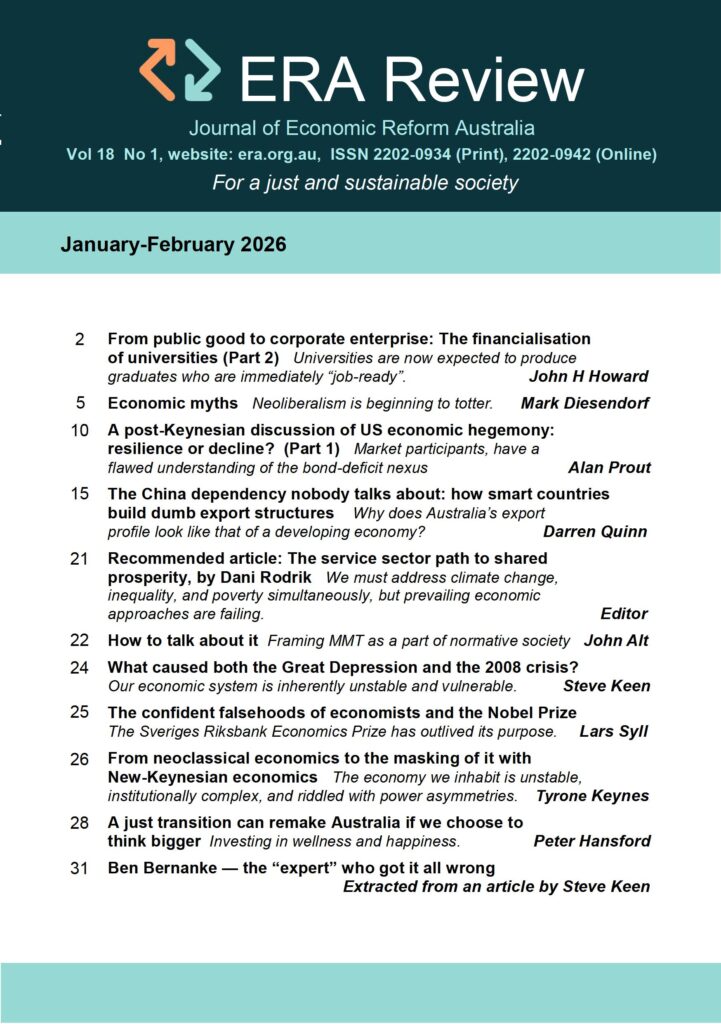Foreign debt explained: it’s not what you think – A conversation between John Kelly and Steven Hail
 An interesting conversation between John Kelly and economist Dr Steven Hail (Adelaide University) was reported in a recent AIM network article [1]. John asked Steven some questions about the much misunderstood subject of Australia’s foreign debt position. This is a transcript of that discussion:
An interesting conversation between John Kelly and economist Dr Steven Hail (Adelaide University) was reported in a recent AIM network article [1]. John asked Steven some questions about the much misunderstood subject of Australia’s foreign debt position. This is a transcript of that discussion:
JOHN: Steven, can you help me out here? There has been talk recently about Australia’s “foreign debt”. What is this? I read recently that Federal government foreign debt is approx 30% of the overall total, now reported to be about $1.04 trillion. But to whom do we owe it and why? What did we borrow it for?
STEVEN: We didn’t borrow it at all. The rest of the world chose to buy it. Any- one can buy Australian government securities, just as anyone can hold Australia’s currency. Australia’s negative net international investment position in total is about 60% of our GDP, where it has been for a long time. It is mainly in the form of private and semi-government (state) bonds, but some of it (and an increasing amount, due to their safety) is in the form of Australian government securities. This has been a problem, as it has been hard for Australian banks to get enough Australian government bonds to meet their regulatory requirements, since there are not enough of them in existence to meet the demand. It is entirely the wrong way around to think of it as our borrowing from someone.
Instead, the rest of the world chooses to net export to Australia (as it has every year since 1974) and holds the AUD it is earning in the form of Australian dollar assets. It is a portfolio decision of foreign investors, in a world where there are no controls on the assets they buy, and nothing to do with a need for us or the Government borrow. Moreover, the securities are in our own currency, or to the extent that private bonds are in foreign currency, are hedged against foreign exchange risk more than 100%.
The problem is that people who imagine they know something, and in fact really don’t understand anything, end up imagining that this is the situation in Australia – that the government goes out looking for foreigners to buy its debt. And that is total nonsense. The Government chooses to issue bonds – which it could easily just not issue at all.
Foreigners then choose to buy some of those bonds. End of story.
JOHN: So is this “foreign debt” so called, our current account balance, our terms of trade, our trade deficit where the RBA holds accounts on behalf of foreign central banks in $AUD which can only be spent here? Does the government enter into contracts written in a foreign currency (say $US) to buy stuff like submarines etc?
STEVEN: We don’t refer to a ‘foreign debt’. We refer to a negative net international investment position. It means that, in terms of Australian dollars, the holdings the rest of the world has on Australian equities, bonds and other financial assets are greater than the holdings Australian residents have over foreign equities, bonds and other financial assets. It is basically the result of our previous current account deficits, stretching back over many years, which are themselves the result of the rest of the world wanting to save our currency. It is nothing to do with the RBA, really. It is not in foreign currency. We have no unhedged net foreign currency liabilities. In fact, we have net foreign currency assets, you might be surprised to know. While the government enters into foreign currency denominated contracts sometimes, it always buys the foreign currency to fulfil them on the foreign exchange market, and does not borrow in foreign currency. Short term trade credit is insignificant.
JOHN: So, rounding things off, if that’s possible, we have no foreign debt (that is, monies borrowed and owing to another country in their currency), all government securities, bonds, treasury notes are issued in $AUD available to overseas buyers, but as we are the currency issuer, these can always be
paid; our trade deficit is ongoing but does not involve exposure to any foreign currency and all foreign currency contracts are paid for by buying foreign currency, not borrowing. Have I understood it correctly? Am I right in thinking that our trade deficit is foreign ownership of $AUD currency deposited in RBA accounts?
Just a minor correction to the above. I realize we hold foreign currencies in various country’s central banks with whom we have a trade surplus.

STEVEN: Nothing to do with a trade surplus. Trade makes up less than 1% of the turnover of the foreign exchange market. We hold some funds with foreign central banks for liquidity purposes, but also hold foreign government securities, as part of our foreign exchange reserves. Nothing to do with trade. I should add that such reserves are of use if the RBA decides to trade in currencies to influence exchange rates. We have a freely floating currency, but the RBA does nevertheless sometimes intervene to nudge the market – particularly if the currency is seen to be moving too quickly in one direction.
JOHN: So where does this $1.04 trillion figure come from? The AOFM website shows only $443 billion on issue.
STEVEN: The private sector, and it is a gross figure, not a net one.
JOHN: Right. Now I get it. Thanks.






























